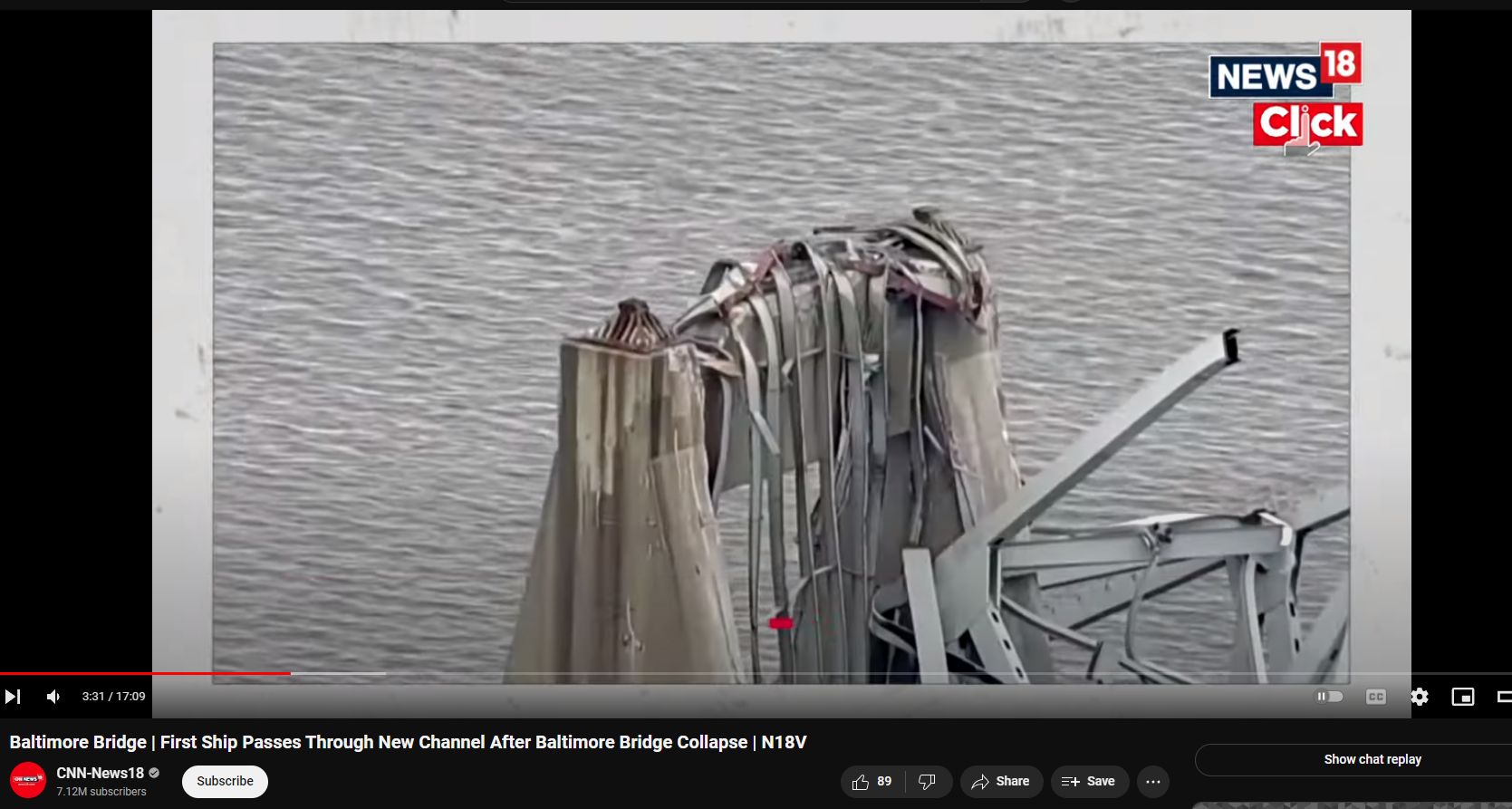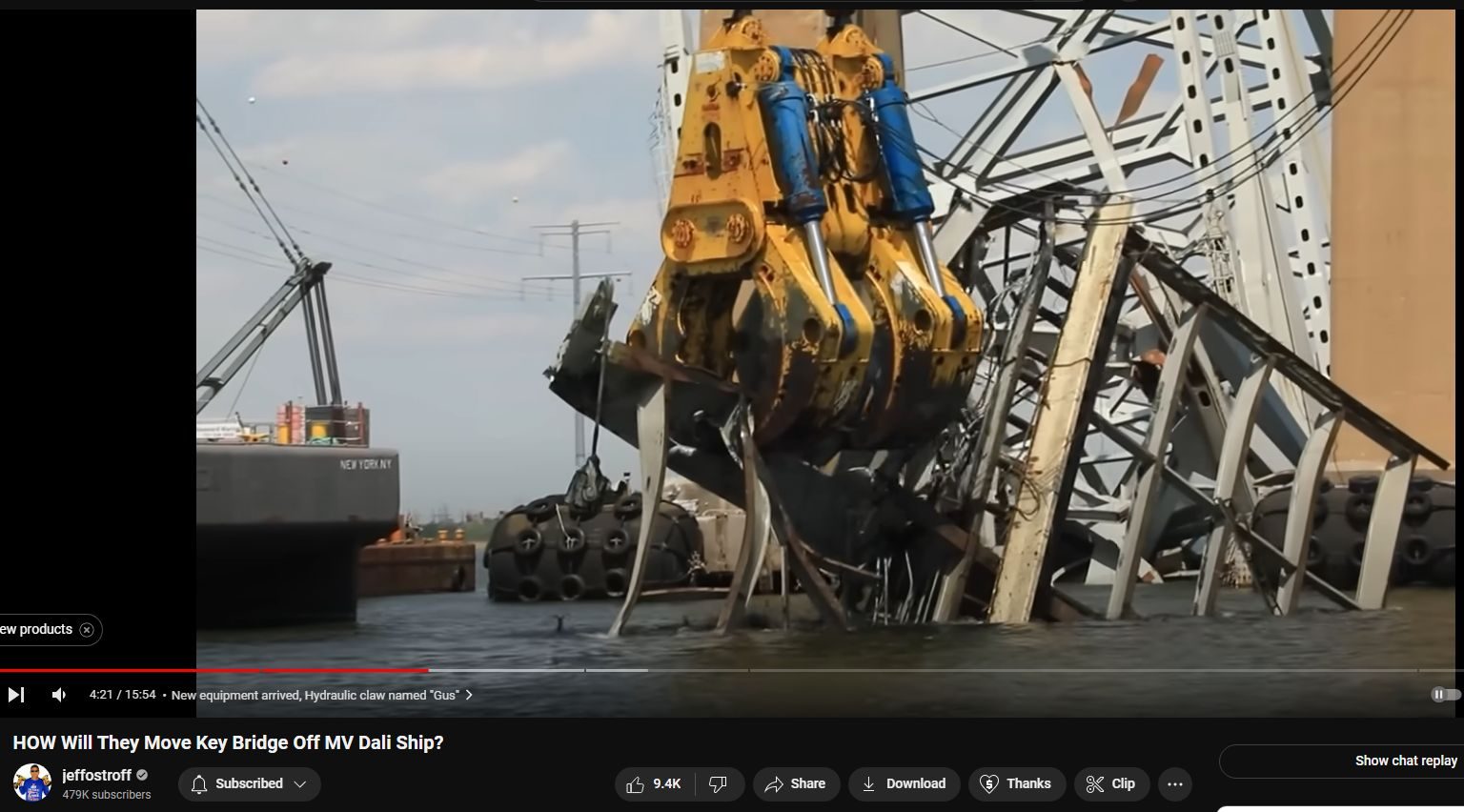“This was a trillion-dollar costly event, ongoing, and yet all culpable persons remain unnamed, kept totally anonymous, with some reportedly having been slyly ‘escaped’ from the country! There is, in fact, zero publicly-verifiable evidence that any genuine Captain, Pilots or Crew ever existed; was DALI a remote-controlled ghost-ship on kamikazee mission from its outset? No waves nor sounds at all were recorded nor reported by any nearby persons nor cameras. No interviews exist with supposed survivors; “family and friends” etc interviews reveal ‘dupers-delight’ micro-facial-expressions with other hallmarks suggestive of fraud. Rampant is the extremely suspicious damage with blatantly visible, verifiable anomalies totally inexplicable (and ignored) by official theory or story. Grand payola galore is already underway with loads more coming. This is another audacious yet sublime crime, militarized from gov to salvage to rebuild. There was no rescue skiff on scene as required by OSHA. No horn blasts from ship warned of imminent collision. The ship departed despite dire electrical problems, illegal at any time and even more highly unusual in the cold, dark night-time (part #94, first ‘after-sundown departure’ in two years). Criminal was this manufactured event, through and through, and that’s before considering the absurdly high number of other anomalies including the complicit, worthless, ‘kept-pet’ mass-media…”
Part #91 adapted from a video comment
Index . Oddity List . Official Story . Summary
No warping, wilting or melting
Catastrophically overstressed structural steel cracks and snaps, not melts and wilts
That even one steel support girder melted, wilted and drooped from the North Pillar indicates that additional energy must have been applied.
That all steel support girders at the North Pillar melted and wilted and were left drooping indicates quite a considerable amount of additional energy was applied.
The only two known mechanisms to provide such energy are (1) a blast furnace, and (2) Directed Energy Weapons. No blast furnace was present.

Catastrophically overstressed structural steel cracks and snaps, not melts and wilts. The molten steel could have only been caused by Directed Energy Weapons which superheat via eddy currents generated by microwave energy applied in exotic beam weaponry.
See Also
See also Part #7 – North Pillar. Wilted Steel. Smoking Gun. Otherworldly evidence.
See also Part #65
See also Part #71
Shatter Before Your Eyes
BELOW: Watch the sturdy structural steel fracture and shatter, “rip apart” BUT NOT bending. Bending, warping, wilting requires superheating which is caused by Directed Energy Weapons. The steel was superheated and wilted before and during the collapse; afterwards, it’s back to normal, as expected. Below is evidence that the bridge steel is in fact rigid and does not bend, distort, warp or wilt.
No bending, warping or wilting but instead cracking, snapping and shattering.

“…so they tried to pull up this giant piece and part of it just kind of ripped apart under its own weight and fell back down” — NONE OF THE GIRDERS BENT — so why are there so many bent girders to begin with ??” (Because Directed Energy Weapons superheated the steel girders until they warped and wilted.)
4:20 into
BELOW: Expected sudden cracking and shattering of rigid steel girders exposed to natural (non-DEW) forces appears ~4:16 in the Jeff Ostroff video showing a girder snap during lifting by “the claw” https://www.youtube.com/watch?v=XJHSfo2SLw8&t=416s — Cracking and snapping is the expected behavior of the materials, and since no DEW was being applied at this time, no melting and wilting was observed. Cracking and snapping is what parts of the bridge were expected to have done; this explains the surprise amongst professional engineers and shock to general public.
It’s as simple as that.
Steel girders never catastrophically melt and wilt except under blast-furnce or DEW exposure. Once a mind realizes that simple fact, nothing else makes more sense than DEW. The plain economic explanation of “why” then clinches total sensibility: The bridge was taken down to makeway for more and larger ships. It’s as simple as that.

Unusual Steel Deformation: A Case for Directed Energy Weapons
In the realm of structural engineering, understanding how structural steel behaves under stress is crucial. Typically, steel girders will crack, snap, or shatter under unusual loads rather than permanently deforming or bending without any visible signs of damage. Observations of radical bends without cracking or splitting raise an important question: could exotic beam weaponry, specifically directed energy weapons (DEWs), be responsible for these anomalies?
Structural Steel Behavior Under Stress
Structural steel girders are designed to withstand significant loads and stresses, but their failure modes are well-documented and predictable:
– **Cracking and Snapping**: Under high stress or impact, steel girders will develop cracks and eventually snap due to brittle fracture. This is common in situations involving sudden impacts or extreme temperatures.
– **Shattering**: In extreme conditions, such as high-velocity impacts or explosive forces, steel can shatter into pieces.
– **Limited Permanent Deformation**: Permanent deformation or bending typically occurs gradually under prolonged loads and is usually accompanied by visible signs of stress such as cracking or splitting.
The unusual deformation, such as radical bends without cracking or splitting, suggests an atypical mode of failure, possibly involving superheating.
Superheating Steel with Directed Energy Weapons
Directed energy weapons, which employ focused microwave energies, can induce eddy currents within steel structures, leading to intense localized heating:
– **Eddy Currents**: When exposed to microwave beams, steel can develop circulating electric currents. These eddy currents generate significant heat due to electrical resistance.
– **Superheating**: Localized heating from eddy currents can elevate the steel’s temperature to its melting point, approximately 2,500°F (1,370°C), causing it to soften and deform under its own weight or external loads.
– **Radical Deformation**: DEWs can precisely target specific areas of a steel structure, leading to the observed radical bends without the typical signs of structural failure (i.e., localized cracking of steel).
Historical Context: The Star Wars Program
The concept of directed energy weapons is not new. It gained significant attention with the introduction of the Strategic Defense Initiative (SDI), commonly known as “Star Wars,” by President Ronald Reagan in 1983. The SDI aimed to develop advanced missile defense systems, including DEWs, to protect against ballistic missile threats.
Development by Major Defense Contractors
Several major defense contractors have played pivotal roles in developing DEW technologies over the past decades:
– **Raytheon**: A leader in advanced defense technologies, Raytheon has developed a variety of DEWs, including high-energy lasers and microwave weapons.
– **BAE Systems**: Specializing in electronic warfare and advanced weaponry, BAE Systems has significantly contributed to DEW research and development.
– **Lockheed Martin**: Known for its cutting-edge aerospace and defense innovations, Lockheed Martin has developed DEW systems for missile defense and offensive capabilities.
Implications for Infrastructure and Security
The potential use of directed energy weapons to target critical infrastructure has profound security implications:
– **Infrastructure Vulnerability**: The ability of DEWs to superheat and deform structural steel highlights the vulnerability of essential infrastructure to advanced attacks.
– **Disaster Capitalism**: Such attacks can create opportunities for disaster capitalism, where private entities profit from the destruction and subsequent rebuilding efforts.
– **Need for Vigilance**: Recognizing the signs of DEW attacks is crucial for developing effective countermeasures and ensuring infrastructure resilience.
Conclusion: Addressing the Threat of Directed Energy Weapons
The unusual deformation of steel girders and other structural components warrants a closer examination of the potential role of directed energy weapons. Understanding the capabilities and development of DEWs, driven by major defense contractors, is essential for enhancing security and preparedness. By acknowledging the role of advanced military technologies and their application in infrastructure attacks, we can better protect our communities and critical infrastructure from emerging threats.